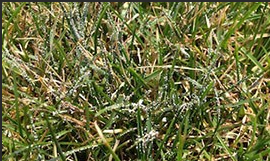In the last month, you may have noticed your lawn, flowers, and vegetables starting to struggle. In the first three weeks of July, we received three months’ worth of rainfall. All of that moisture combined with intense humidity created the perfect breeding ground for lawn diseases and weeds. Diseases that are currently spreading rapidly through lawns include pythium, brown patch, red thread, slime mold, and rust.
Many of these diseases require the same treatment: stop watering.
If you stopped watering when we started receiving steady rainfall, you’ve likely gotten ahead of these diseases. If your irrigation system has still been watering your lawn regularly, it’s time to turn it off until your lawn has a chance to recover and we have a steady dry spell. Because of the consistent rain and humidity we’ve been receiving, lawns have not had a chance to dry out and these stretches of moisture provide the perfect environment for fungal growth. Your lawn may appear brown and dried out- this is not the case. The brown patches are diseased and are made worse by watering. Severe areas that do not recover may need to be reseeded in the fall.
Additional tips to avoid/treat these diseases:
Don’t let your lawn get too long!
Don’t mow your lawn when it is wet!
Here’s hoping for drier weather and quick recoveries!










